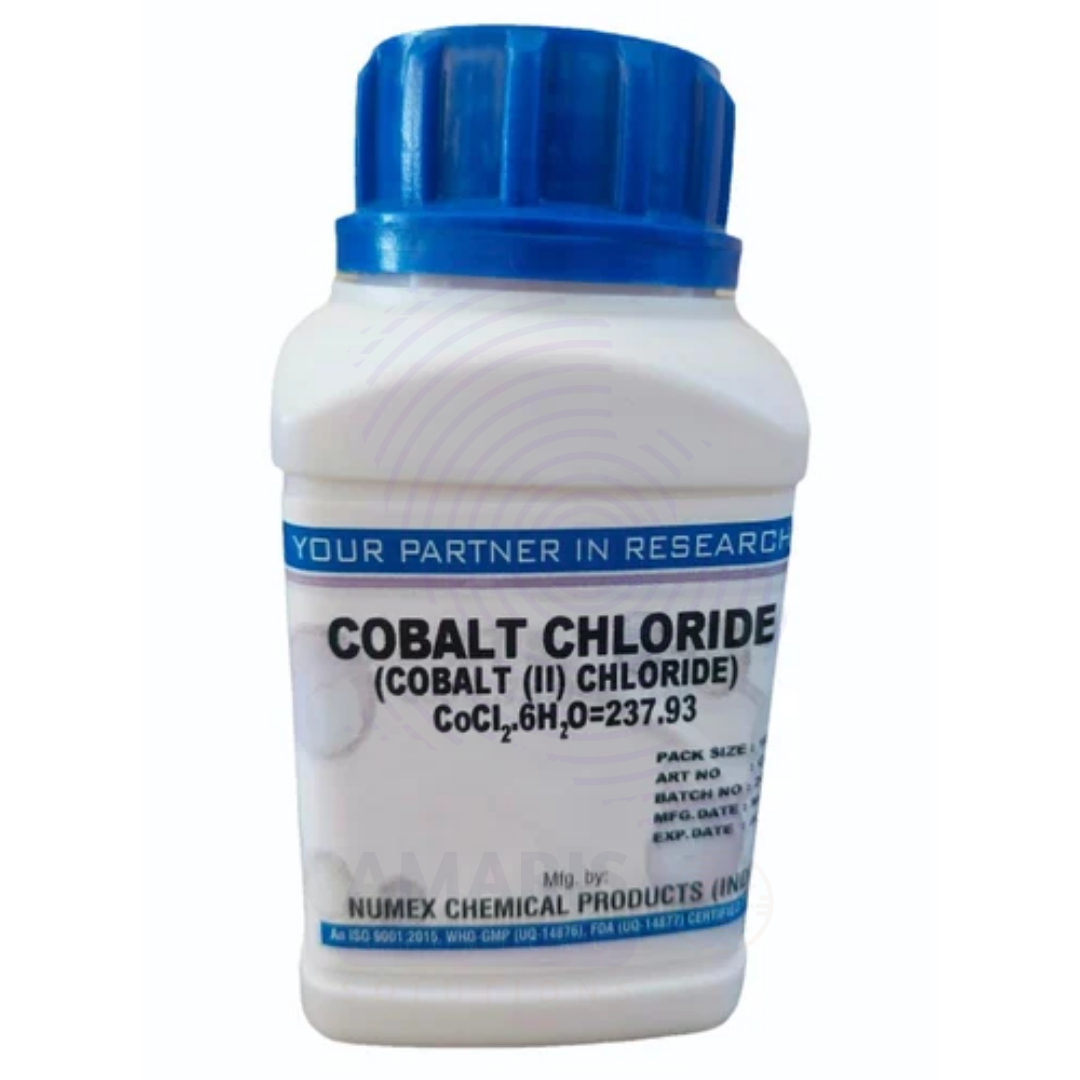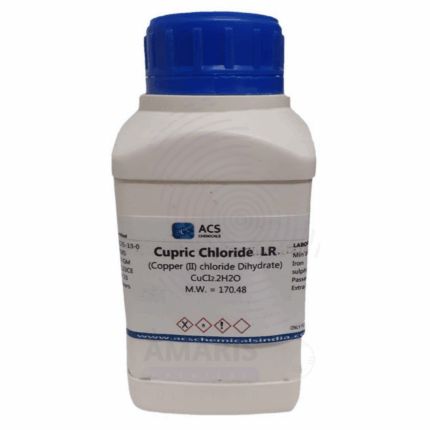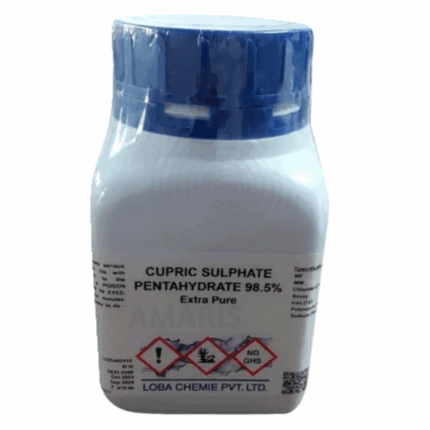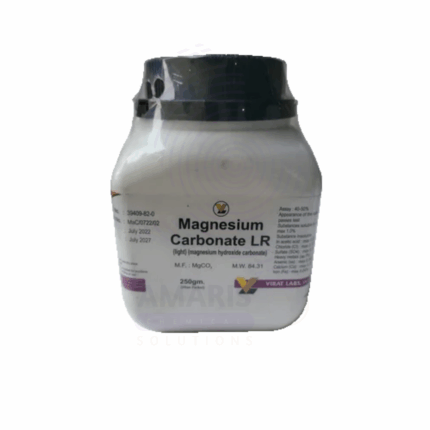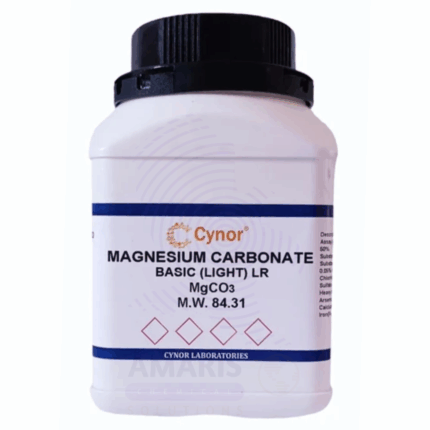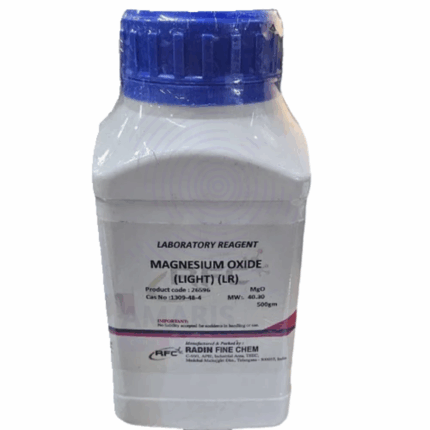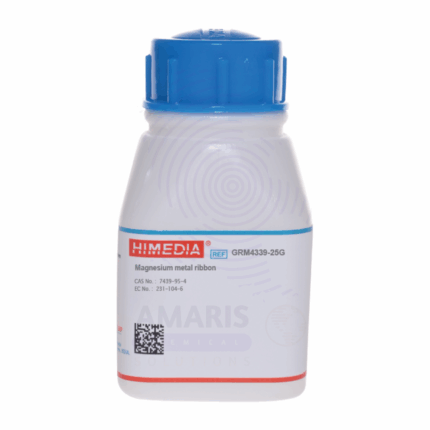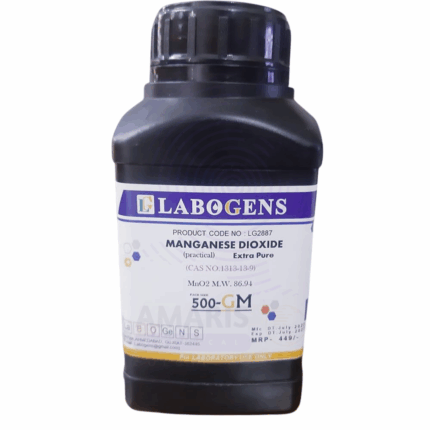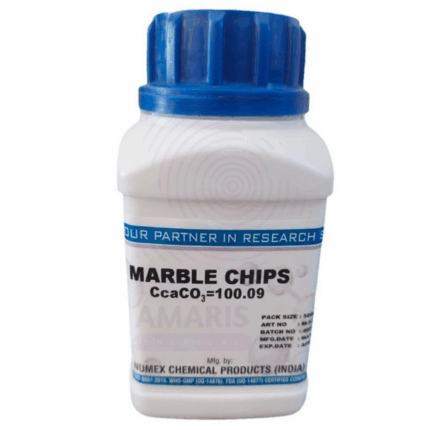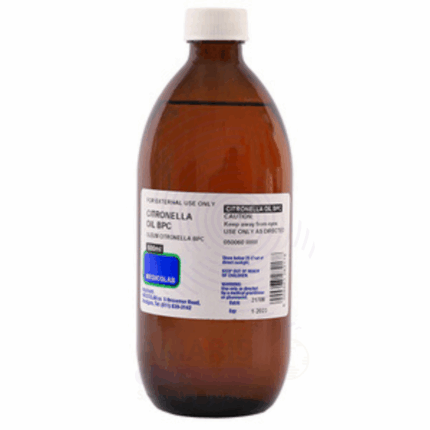
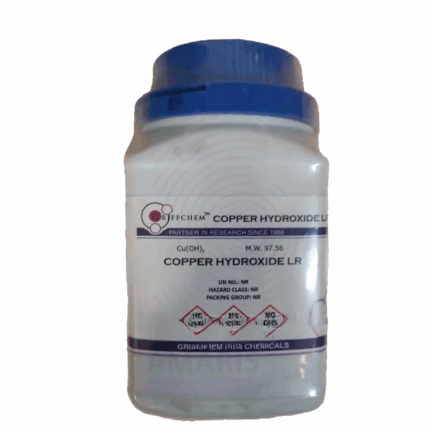
Cobalt Chloride Extra Pure
$ 23.20 Original price was: $ 23.20.$ 23.12Current price is: $ 23.12.
Cobalt Chloride Extra Pure is a high-purity, pink to deep purple crystalline compound widely used in laboratories for analytical, inorganic, and coordination chemistry. It is especially valued as a humidity indicator, turning from blue (anhydrous) to pink (hydrated) depending on moisture levels. In research settings, it serves as a precursor for synthesizing other cobalt compounds, as well as a reagent in qualitative tests for water, ammonium ions, and complex formation studies. Its extra pure grade ensures precise, contamination-free results, making it ideal for experiments requiring high accuracy. Proper handling with gloves and storage in airtight containers are recommended due to its toxic and moisture-sensitive nature.
Cobalt Chloride Extra Pure
Primary Uses
- Humidity Indicator in Desiccators
- Cobalt(II) chloride is widely used as a moisture indicator due to its color change:
- Blue (anhydrous) → Pink (hydrated)
Ideal for monitoring humidity levels in desiccators or sealed lab containers.
- Blue (anhydrous) → Pink (hydrated)
- Cobalt(II) chloride is widely used as a moisture indicator due to its color change:
- Analytical Chemistry (Qualitative Tests)
- Acts as a reagent for detecting water in solvents and gases.
- Used in chloride ion detection and complex ion formation tests.
- Coordination Chemistry Studies
- Frequently used in inorganic labs to synthesize and study transition metal complexes, especially with ligands like ammonia, ethylenediamine, etc.
- Thermochromic Demonstrations
- Used in educational demonstrations to visually show reversible chemical reactions involving water of hydration.
Secondary Uses
- Electrochemical Studies
- Investigated in redox reactions, electroplating, and battery chemistry involving cobalt species.
- Teaching Tool in General Chemistry
- Demonstrates hydration/dehydration reactions, oxidation states, and Le Chatelier’s Principle in equilibrium reactions.
- Precursor for Cobalt-based Catalysts
- Serves as a starting material for preparing cobalt oxide catalysts and heterogeneous catalytic materials in lab-scale synthesis.
- pH-Sensitive Ink Experiments
- Used in preparing invisible inks that appear or disappear with pH or heat changes — common in educational chemistry projects.
| PACK SIZE |
100 grams Plastic Tin |
|---|
1. Basic Identification Attributes
- Chemical Name: Cobalt(II) Chloride
- CAS Number: 7646-79-9
- Chemical Formula: CoCl₂ (anhydrous), CoCl₂·6H₂O (hexahydrate)
- Molar Mass:
- Anhydrous: 129.84 g/mol
- Hexahydrate: 237.93 g/mol
- Synonyms: Cobaltous chloride, cobalt dichloride
2. Physical & Chemical Properties
- Appearance:
- Anhydrous: Blue crystalline solid
- Hexahydrate: Pink to purple crystals
- Solubility: Highly soluble in water and alcohol
- Melting Point:
- Anhydrous: 735°C
- Hexahydrate: Loses water at ~86°C
- Boiling Point (Anhydrous): ~1049°C
- pH (1% solution): ~4–5
- Odor: Odorless
3. Safety & Hazard Attributes
- GHS Classification:
- ☣️ Danger
- H302: Harmful if swallowed
- H317: May cause allergic skin reaction
- H334: May cause allergy or asthma symptoms
- H350i: May cause cancer by inhalation
- H360F: May damage fertility
- H410: Very toxic to aquatic life
- NFPA Ratings:
- Health: 3
- Flammability: 0
- Reactivity: 0
- First Aid Measures:
- Inhalation: Move to fresh air; seek immediate medical attention
- Skin Contact: Rinse with soap and water; remove contaminated clothing
- Eye Contact: Flush eyes with water for 15 minutes
- Ingestion: Rinse mouth; do not induce vomiting; seek medical advice
4. Storage & Handling Attributes
- Storage Conditions:
- Keep in a tightly closed container
- Store in a dry, cool, well-ventilated area
- Protect from moisture and incompatible substances (e.g., strong oxidizers)
- Shelf Life: Stable under recommended storage conditions
- Container Requirements: Use corrosion-resistant material (glass, HDPE)
5. Regulatory & Compliance Attributes
- EINECS Number: 231-589-4
- REACH Status: Subject to authorisation; classified as SVHC
- IARC Classification: Group 2B (possibly carcinogenic to humans)
6. Applications in Laboratory & Industry
- Laboratory Use:
- Humidity indicator (color change: blue ↔ pink)
- Synthesis of coordination compounds
- Analytical chemistry (e.g., tests for ammonia, chloride)
- Other Uses:
- Electroplating and surface treatment
- Ceramics and glass colorants
- Pigment production
SAFETY PRECAUTIONS
- PPE Required:
- Lab coat
- Chemical-resistant gloves (e.g., nitrile)
- Safety goggles or face shield
- Dust mask or use in a fume hood
- Handling:
- Handle with care in a well-ventilated area.
- Avoid generating dust.
- Do not breathe dust or vapors.
- Avoid contact with skin, eyes, and clothing.
- Storage:
- Store in a tightly sealed container.
- Keep in a cool, dry, well-ventilated place.
- Protect from moisture and incompatible materials (e.g., strong acids or oxidizers).
FIRST AID MEASURES
- Inhalation:
- Remove the person to fresh air immediately.
- Seek medical attention if symptoms like coughing or shortness of breath occur.
- Skin Contact:
- Wash with soap and plenty of water for at least 15 minutes.
- Remove contaminated clothing.
- Seek medical advice if irritation develops.
- Eye Contact:
- Rinse thoroughly with water for 15 minutes while lifting eyelids.
- Get immediate medical attention.
- Ingestion:
- Rinse mouth with water.
- Do not induce vomiting.
- Seek immediate medical attention.
- Cobalt compounds are toxic if ingested.
FIREFIGHTING MEASURES
- Flammability:
- Non-flammable, but may emit toxic fumes when heated.
- Decomposition Products:
- Cobalt oxides, hydrogen chloride gas
- Suitable Extinguishing Media:
- Use extinguishing media appropriate for surrounding materials (CO₂, dry powder, foam, water spray).
- Protective Equipment for Firefighters:
- Full protective suit and self-contained breathing apparatus (SCBA)


 Preservatives(food)
Preservatives(food) Flavor Enhancers
Flavor Enhancers Acidulants
Acidulants Sweeteners
Sweeteners Antioxidants
Antioxidants Colorants(food)
Colorants(food) Nutraceutical Ingredients (food)
Nutraceutical Ingredients (food) Nutrient Supplements
Nutrient Supplements Emulsifiers
Emulsifiers
 Collectors
Collectors Dust Suppressants
Dust Suppressants Explosives and Blasting Agents
Explosives and Blasting Agents Flocculants and Coagulants
Flocculants and Coagulants Frothers
Frothers Leaching Agents
Leaching Agents pH Modifiers
pH Modifiers Precious Metal Extraction Agents
Precious Metal Extraction Agents
 Antioxidants(plastic)
Antioxidants(plastic) Colorants (Pigments, Dyes)
Colorants (Pigments, Dyes) Fillers and Reinforcements
Fillers and Reinforcements Flame Retardants
Flame Retardants Monomers
Monomers Plasticizers
Plasticizers Polymerization Initiators
Polymerization Initiators Stabilizers (UV, Heat)
Stabilizers (UV, Heat)
 Antifoaming Agents
Antifoaming Agents Chelating Agents
Chelating Agents Coagulants and Flocculants
Coagulants and Flocculants Corrosion Inhibitors
Corrosion Inhibitors Disinfectants and Biocides
Disinfectants and Biocides Oxidizing Agents
Oxidizing Agents pH Adjusters
pH Adjusters Scale Inhibitors( water)
Scale Inhibitors( water)
 Antioxidants(cosmetic)
Antioxidants(cosmetic) Emollients
Emollients Fragrances and Essential Oils
Fragrances and Essential Oils Humectants
Humectants Preservatives
Preservatives Surfactants(cosmetic)
Surfactants(cosmetic) Thickeners
Thickeners UV Filters
UV Filters
 Fertilizers
Fertilizers Soil Conditioners
Soil Conditioners Plant Growth Regulators
Plant Growth Regulators Animal Feed Additives
Animal Feed Additives Biostimulants
Biostimulants Pesticides (Herbicides, Insecticides, Fungicides)
Pesticides (Herbicides, Insecticides, Fungicides)
 Active Pharmaceutical Ingredients (APIs)
Active Pharmaceutical Ingredients (APIs) Excipients
Excipients Solvents(pharmaceutical)
Solvents(pharmaceutical) Antibiotics
Antibiotics Antiseptics and Disinfectants
Antiseptics and Disinfectants Vaccine Adjuvants
Vaccine Adjuvants Nutraceutical Ingredients (pharmaceutical)
Nutraceutical Ingredients (pharmaceutical) Analgesics & Antipyretics
Analgesics & Antipyretics
 Analytical Reagents
Analytical Reagents Solvents(lab)
Solvents(lab) Chromatography Chemicals
Chromatography Chemicals Spectroscopy Reagents
Spectroscopy Reagents microbiology-and-cell-culture-reagents
microbiology-and-cell-culture-reagents Molecular Biology Reagents
Molecular Biology Reagents Biochemical Reagents
Biochemical Reagents Inorganic and Organic Standards
Inorganic and Organic Standards Laboratory Safety Chemicals
Laboratory Safety Chemicals Specialty Laboratory Chemicals(Special Laboratory Equipment)
Specialty Laboratory Chemicals(Special Laboratory Equipment)
 Demulsifiers
Demulsifiers Hydraulic Fracturing Fluids
Hydraulic Fracturing Fluids Scale Inhibitors(oil)
Scale Inhibitors(oil) Surfactants(oil)
Surfactants(oil) Drilling Fluids
Drilling Fluids
 Dyes and Pigments
Dyes and Pigments Bleaching Agents
Bleaching Agents Softening Agents
Softening Agents Finishing Agents
Finishing Agents Antistatic Agents
Antistatic Agents
 Admixtures
Admixtures Waterproofing Agents
Waterproofing Agents Sealants and Adhesives
Sealants and Adhesives Curing Compounds
Curing Compounds Concrete Repair Chemicals
Concrete Repair Chemicals Anti-Corrosion Coatings
Anti-Corrosion Coatings
 Surfactants(cleaning)
Surfactants(cleaning) Builders
Builders Enzymes
Enzymes Solvents (Cleaning)
Solvents (Cleaning) Fragrances
Fragrances
 Electronic Chemicals
Electronic Chemicals Catalysts
Catalysts Lubricants
Lubricants Photographic Chemicals
Photographic Chemicals Refrigerants
Refrigerants Automotive chemicals
Automotive chemicals Pyrotechnic Chemicals
Pyrotechnic Chemicals
 Biodegradable Surfactants
Biodegradable Surfactants Bio-based Solvents
Bio-based Solvents Renewable Polymers
Renewable Polymers Carbon Capture Chemicals
Carbon Capture Chemicals Wastewater Treatment Chemicals
Wastewater Treatment Chemicals
 Pigments
Pigments Solvents(paint)
Solvents(paint) Specialty Coatings
Specialty Coatings Binders/Resins
Binders/Resins Additives
Additives Driers
Driers Anti-Corrosion Agents
Anti-Corrosion Agents Functional Coatings
Functional Coatings Application-Specific Coatings
Application-Specific Coatings
 Fresh Herbs
Fresh Herbs Ground Spices
Ground Spices Whole Spices
Whole Spices Spice Blends
Spice Blends Dried Herbs
Dried Herbs
 Leavening Agents
Leavening Agents Dough Conditioners
Dough Conditioners Flour Treatments
Flour Treatments Fat Replacers
Fat Replacers Decoratives
Decoratives Preservatives(baking)
Preservatives(baking)
 Plasticizers & Softeners
Plasticizers & Softeners Reinforcing Agents
Reinforcing Agents Adhesion Promoters
Adhesion Promoters Vulcanizing Agents
Vulcanizing Agents Antidegradants
Antidegradants Blowing Agents
Blowing Agents Fillers & Extenders
Fillers & Extenders Accelerators & Retarders
Accelerators & Retarders